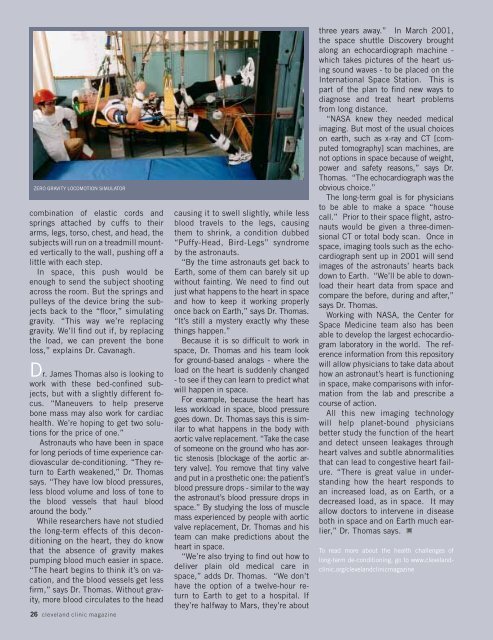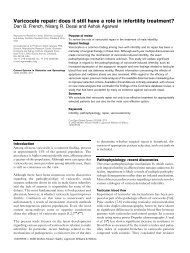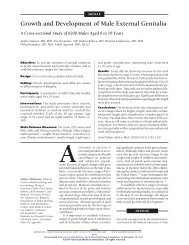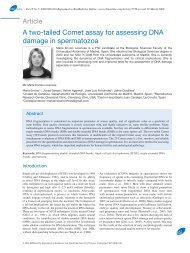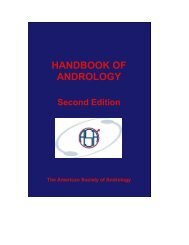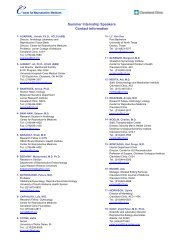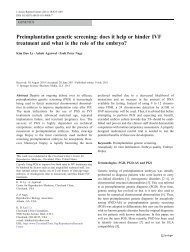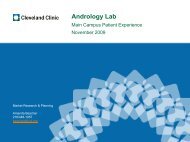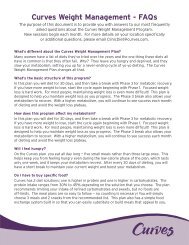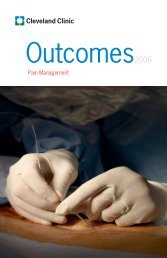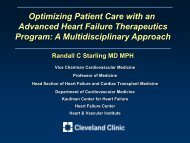clevelandclinicmagazine - Best Hospitals, US News best hospitals
clevelandclinicmagazine - Best Hospitals, US News best hospitals
clevelandclinicmagazine - Best Hospitals, US News best hospitals
- No tags were found...
You also want an ePaper? Increase the reach of your titles
YUMPU automatically turns print PDFs into web optimized ePapers that Google loves.
ZERO GRAVITY LOCOMOTION SIMULATORcombination of elastic cords andsprings attached by cuffs to theirarms, legs, torso, chest, and head, thesubjects will run on a treadmill mountedvertically to the wall, pushing off alittle with each step.In space, this push would beenough to send the subject shootingacross the room. But the springs andpulleys of the device bring the subjectsback to the “floor,” simulatinggravity. “This way we’re replacinggravity. We’ll find out if, by replacingthe load, we can prevent the boneloss,” explains Dr. Cavanagh.Dr. James Thomas also is looking towork with these bed-confined subjects,but with a slightly different focus.“Maneuvers to help preservebone mass may also work for cardiachealth. We’re hoping to get two solutionsfor the price of one.”Astronauts who have been in spacefor long periods of time experience cardiovascularde-conditioning. “They returnto Earth weakened,” Dr. Thomassays. “They have low blood pressures,less blood volume and loss of tone tothe blood vessels that haul bloodaround the body.”While researchers have not studiedthe long-term effects of this deconditioningon the heart, they do knowthat the absence of gravity makespumping blood much easier in space.“The heart begins to think it’s on vacation,and the blood vessels get lessfirm,” says Dr. Thomas. Without gravity,more blood circulates to the head26 cleveland clinic magazinecausing it to swell slightly, while lessblood travels to the legs, causingthem to shrink, a condition dubbed“Puffy-Head, Bird-Legs” syndromeby the astronauts.“By the time astronauts get back toEarth, some of them can barely sit upwithout fainting. We need to find outjust what happens to the heart in spaceand how to keep it working properlyonce back on Earth,” says Dr. Thomas.“It’s still a mystery exactly why thesethings happen.”Because it is so difficult to work inspace, Dr. Thomas and his team lookfor ground-based analogs - where theload on the heart is suddenly changed- to see if they can learn to predict whatwill happen in space.For example, because the heart hasless workload in space, blood pressuregoes down. Dr. Thomas says this is similarto what happens in the body withaortic valve replacement. “Take the caseof someone on the ground who has aorticstenosis [blockage of the aortic arteryvalve]. You remove that tiny valveand put in a prosthetic one: the patient’sblood pressure drops - similar to the waythe astronaut’s blood pressure drops inspace.” By studying the loss of musclemass experienced by people with aorticvalve replacement, Dr. Thomas and histeam can make predictions about theheart in space.“We’re also trying to find out how todeliver plain old medical care inspace,” adds Dr. Thomas. “We don’thave the option of a twelve-hour returnto Earth to get to a hospital. Ifthey’re halfway to Mars, they’re aboutthree years away.” In March 2001,the space shuttle Discovery broughtalong an echocardiograph machine -which takes pictures of the heart usingsound waves - to be placed on theInternational Space Station. This ispart of the plan to find new ways todiagnose and treat heart problemsfrom long distance.“NASA knew they needed medicalimaging. But most of the usual choiceson earth, such as x-ray and CT [computedtomography] scan machines, arenot options in space because of weight,power and safety reasons,” says Dr.Thomas. “The echocardiograph was theobvious choice.”The long-term goal is for physiciansto be able to make a space “housecall.” Prior to their space flight, astronautswould be given a three-dimensionalCT or total body scan. Once inspace, imaging tools such as the echocardiographsent up in 2001 will sendimages of the astronauts’ hearts backdown to Earth. “We’ll be able to downloadtheir heart data from space andcompare the before, during and after,”says Dr. Thomas.Working with NASA, the Center forSpace Medicine team also has beenable to develop the largest echocardiogramlaboratory in the world. The referenceinformation from this repositorywill allow physicians to take data abouthow an astronaut’s heart is functioningin space, make comparisons with informationfrom the lab and prescribe acourse of action.All this new imaging technologywill help planet-bound physiciansbetter study the function of the heartand detect unseen leakages throughheart valves and subtle abnormalitiesthat can lead to congestive heart failure.“There is great value in understandinghow the heart responds toan increased load, as on Earth, or adecreased load, as in space. It mayallow doctors to intervene in diseaseboth in space and on Earth much earlier,”Dr. Thomas says.To read more about the health challenges oflong-term de-conditioning, go to www.clevelandclinic.org/<strong>clevelandclinicmagazine</strong>


